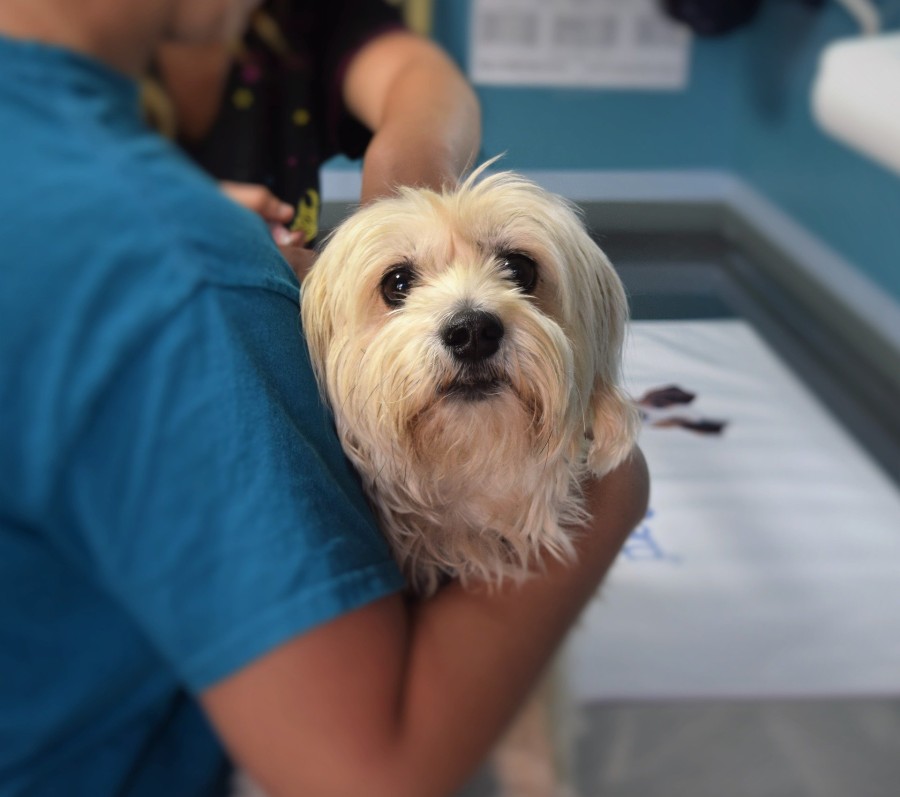Why Some Chicago Dogs Are Getting Sick From Rats, And What You Can Do About It
Rats can carry a disease called leptospirosis. We look at how it’s transmitted and what dog owners can do to protect their pet.
By Monica Eng

Why Some Chicago Dogs Are Getting Sick From Rats, And What You Can Do About It
Rats can carry a disease called leptospirosis. We look at how it’s transmitted and what dog owners can do to protect their pet.
By Monica EngAs part of the 2020 Citizens’ Agenda project, WBEZ is reporting on the issues you told us you care about most ahead of November’s elections. Many of you wanted your officials to address the large number of rats in your neighborhoods. This reporting was driven by audience responses to our Citizens’ Agenda Survey.
Dave and Jamie Rossi had been expecting a new arrival in their Lakeview home for months. And when the brown puppy named Ziggy finally arrived in early September, they fell in love.

“He had the most beautiful green eyes that stole your soul and big floppy ears,” said Jamie Rossi, a Chicago Public School teacher.
Within a couple of weeks, though, the Rossis started noticing a change in their puppy.
Ziggy stopped eating much, and began to throw up several times a day.
“And he was tired, lethargic and wanted to sleep all the time,” David Rossi remembered.
After a few visits to the vet, doctors diagnosed Ziggy with leptospirosis, a bacterial disease that attacks the liver and kidneys. Ziggy underwent multiple dialysis and plasma treatments. But after less than a week in the hospital, he died.
The Rossis were left with broken hearts — but also $45,000 in medical bills that they say they’ll struggle to pay for years even with the help of a GoFundMe page.
Sadly, Ziggy’s death from leptospirosis fits in with a disturbing pattern doctors and researchers have tracked in Chicago recently. While rats carry dozens of diseases that can be transmissible to humans and pets, an increasing number of dogs, in some Chicago neighborhoods, have been getting sick with leptospirosis.
“This season we have unfortunately seen quite a lot of puppies who have been affected [by leptospirosis],” said Dr. Karina Creighton, veterinary critical care specialist at Veterinary Specialty Center. And while dogs can catch the disease from many animals, the strain Creighton has seen most often is the one associated with rats.
And through WBEZ’s ongoing Citizens Agenda project, Curious City has heard from a lot of Chicagoans who are concerned about rats in their neighborhood. So we thought we’d look at how leptospirosis is transmitted, why more dogs seem to be getting it and what people need to do to protect their pets.
What is leptospirosis and how do dogs catch it from rats?
Leptospirosis is a bacterial disease and one of more than 50 rat-borne diseases which also include hantavirus, e.coli and salmonella. In humans, it mimics many of the symptoms of the flu. And while rat-borne leptospirosis did kill at least one person in New York in 2017, it is not easily transmitted to people, and rarely fatal to humans in the Northern Hemisphere, as it’s far more common in tropical areas.
It has, however, become increasingly dangerous to dogs, which can contract the disease by coming in contact with infected rat urine on the ground or in a puddle. Dogs might drink that urine that’s on the ground or might step in it and then lick their feet.
“It’s a very big concern,” said Natalie Marks, a veterinarian at Blum Animal Hospital in Lakeview who does educational talks for other vets on the disease with support from Merck Animal Health, which makes a vaccine. “Up to 90 percent of urban rats can carry leptospirosis, so I tell clients, ‘If you are seeing a rat assume there is lepto there until proven otherwise.‘”

Rebecca Fyffe, director of research at Landmark Pest Management, often hears from citizens after they have learned about leptospirosis the hard way.
“We’ve received a lot of telephone calls this year and last year from people whose dogs have leptospirosis,” she said.
Many of the cases were mild but others were severe or deadly, Fyffe said.
Why are more dogs catching leptospirosis from rats?
Since there is no central agency that collects pet disease statistics in Illinois, Marks says she can’t specifically track the increase in cases. But she says she’s noticed a marked uptick in cases at her clinic recently and she attributes it to a few things.
“We’ve had the puppy explosion during COVID when so many people are getting pets who have never had a pet before,” she said, noting that young puppies are extra vulnerable before they get all their vaccinations. Leptospirosis is not a core vaccination at this time but at least one study suggests vaccinated dogs are 20 times less likely to be infected.
Another factor Marks pointed to is that because of the pandemic, dogs are coming into more frequent contact with rats because rats have moved into more residential areas.
“The [rats] used to congregate behind restaurants and Wrigley Field, places with a large abundance of food,” Marks said. “But with so many places closed or doing modified hours they have been going to residential garbage cans, garages and backyards. And that means our dogs are exposed to more risk factors.”

Marks also said that some vets are better informed about the disease and recognizing new symptoms, like frequent urination, sooner so they’re testing more often for the disease.
“We used to think of testing dogs for lepto when they had a fever, vomiting and changes in their blood work in their kidneys and liver. But now we know there is a carrier form of leptospirosis where dogs might come in for a vaccination appointment and the parent might say ‘my dog is peeing more in the house,’ and that itself can be a sign of leptospirosis.”
And Marks cautions that all that urination by the family dog in the house can pose more of a danger to humans because anyone who comes into contact with the infected dog’s urine could potentially contract it.
“And lots of these people may have young kids who would be on the floor and putting their fingers in their mouth,” she said.
Where are the most cases?
In recent years, researchers have looked at the concentration of leptospirosis in Chicago dogs and rats and discovered that, unsurprisingly, they overlap. In neighborhoods where more rats carry the disease, more dogs contract it.
One Ohio State University study published in 2019 found two significant clusters of sick dogs came from the zip codes of 60618 and 60647, roughly the area around North Center and Logan Square.
And a 2020 study led by Lincoln Park Zoo researcher Maureen Murray looked at the prevalence of leptospirosis in Chicago rats using 200 rat corpses from all over the city. It found concentrations of leptospirosis in North Side neighborhoods (including Logan Square, Near North Side and Lakeview) with high numbers of standing water complaints. And although several North Side areas had leptospirosis-infected rats, the neighborhood with five times more infected than any other area was Lakeview, where Ziggy lived.
Lead researcher Maureen Murray said she was not surprised to find higher levels of leptospirosis in areas with frequent standing water complaints because the disease can be passed to animals through standing water with infected urine.
Ways to reduce leptospirosis risk
There are several ways to reduce a dog’s risk for leptospirosis. The Ohio State University study suggests that vaccination can offer strong protection. Among the 43 dogs in the study, unvaccinated dogs were 20 times more likely to contract the disease than those who were even partially vaccinated.
Vets also advise keeping dogs away from possibly infected water.
“I would limit their access to standing water and try to walk them in dry areas, and wipe down their paws,” says Dr. Karina Creighton of Veterinary Specialty Center.
Rebecca Fyffe’s company helps clients come up with a plan to reduce the rats on and near their property. But, in the meantime, she advises pet owners keep their puppies indoors until they can have their vaccinations — which they can do as early as eight weeks.
“That’s because there are so many different species of wildlife that can be reservoirs for leptospirosis, that are very common in our backyard,” she said. “That’s everything from raccoons, skunks, rats and other rodents. And they are just so abundant that it is highly likely that an unvaccinated dog will encounter leptospirosis.”
Finally, pet owners can try to reduce rat populations around their own homes by keeping garbage cans closed, removing clutter from their backyard, cleaning up dog feces, minimizing areas with soft dirt and shrubbery and sealing any holes in building foundations.
Curious City will continue to explore strategies to reduce rats in the city in an upcoming story this month. Keep a lookout.
Monica Eng is a WBEZ reporter. Contact her at meng@wbez.org.
